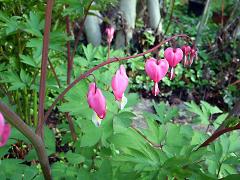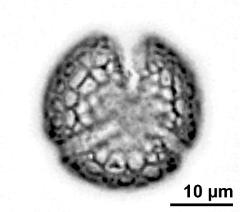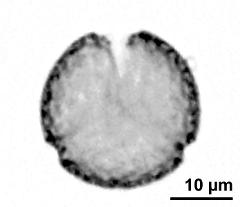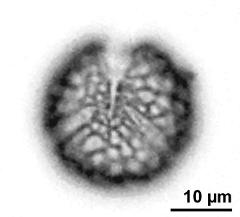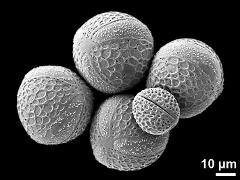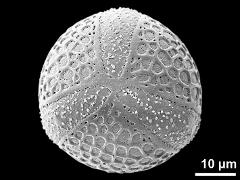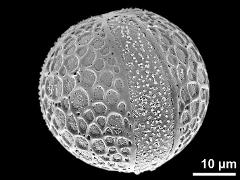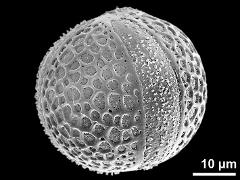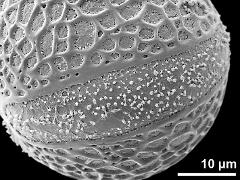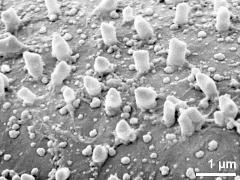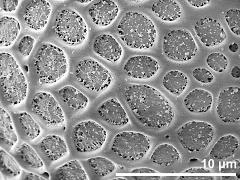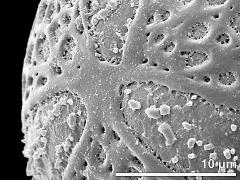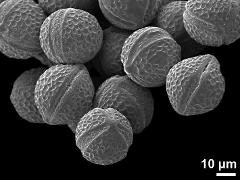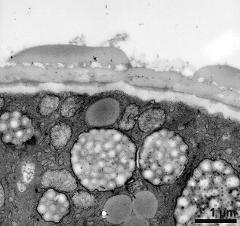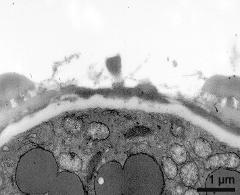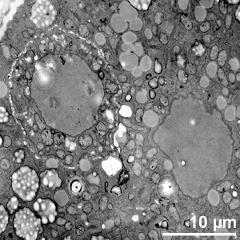Dicentra spectabilis
Taxonomy: Angiospermae, Ranunculales, Papaveraceae, Dicentra
Published: 2016-10-21
Pollen Description
Shape, Size and Aperture
pollen unit: monad, dispersal unit and peculiarities: monad, size (pollen unit): medium-sized (26-50 µm), size of hydrated pollen (LM): -, shortest polar axis in equatorial view (LM): -, longest polar axis in equatorial view (LM): -, shortest diameter in equatorial or polar view (LM): -, longest diameter in equatorial or polar view (LM): -, pollen class: colpate, polarity: isopolar, P/E-ratio: -, shape: spheroidal, outline in polar view: circular, dominant orientation (LM): -, P/E-ratio (dry pollen): prolate, shape (dry pollen): -, outline in polar view (dry pollen): circular, infoldings (dry pollen): aperture(s) sunken, aperture number: 3, aperture type: colpus, aperture condition: colpate, tricolpate, aperture peculiarities: aperture membrane ornamented, margo
Ornamentation and Structure
LM ornamentation LM: reticulate, nexine: -, sexine: -, SEM ornamentation SEM: reticulate, suprasculpture SEM: -, TEM tectum: semitectate, infratectum: columellate, foot layer: continuous, endexine: compact-discontinuous, intine: monolayered, wall peculiarities: -, supratectal element: -
Miscellaneous
pollen coatings: pollenkitt, reserves in cytoplasm: starch, lipids, cell number: 2-celled, Ubisch bodies: present
Annotations: dry pollen only slightly prolate, lemon shaped, or not infolded
Author(s) of diagnosis: Oberschneider, Wolfgang; Halbritter, Heidemarie
Pictures
Picture legend
- inflorescence(s), photographer: Halbritter, H.
- polar view - fresh, acetolyzed, unstained, photographer: Oberschneider, W.
- optical section - fresh, acetolyzed, unstained, photographer: Oberschneider, W.
- polar view - fresh, acetolyzed, unstained, photographer: Oberschneider, W.
- hydrated pollen grains (with dry grain) - fresh, rehydrated (water) & critical point dried & sputter coated with gold, photographer: Halbritter, H.
- polar view - fresh, rehydrated (water) & critical point dried & sputter coated with gold, photographer: Halbritter, H.
- equatorial view - fresh, rehydrated (water) & critical point dried & sputter coated with gold, photographer: Halbritter, H.
- equatorial view - fresh, rehydrated (water) & critical point dried & sputter coated with gold, photographer: Halbritter, H.
- aperture - fresh, rehydrated (water) & critical point dried & sputter coated with gold, photographer: Halbritter, H.
- detail of aperture - fresh, rehydrated (water) & critical point dried & sputter coated with gold, photographer: Halbritter, H.
- exine surface - fresh, rehydrated (water) & critical point dried & sputter coated with gold, photographer: Halbritter, H.
- polar area - fresh, rehydrated (water) & critical point dried & sputter coated with gold, photographer: Halbritter, H.
- dry pollen grains - fresh, sputter coated with gold, photographer: Halbritter, H.
- interapertural area of pollen wall - fresh, glutaraldehyde & osmium & potassium ferrocyanide, Thiéry-test, photographer: Oberschneider, W.
- aperture - fresh, glutaraldehyde & osmium & potassium ferrocyanide, modified Thiéry-test, photographer: Oberschneider, W.
- generative cell (left) and vegetative nucleus - fresh, glutaraldehyde & osmium & potassium ferrocyanide, modified Thiéry-test, photographer: Oberschneider, W.
Literature
- (1997) Phylogeny and classification of Fumariaceae, with emphasis on Dicentra s.l., based on the plastid gene rps16 intron. Pl Syst Evol 206: 411-420
- (1998) Pollenmorphologie der Ranunculanae. Diplomarbeit. Universität Wien : 125 pp
- (1994) Exkursionsflora von Österreich : 1180
- (1998) Preparing living pollen material for scanning electron microscopy using 2,2-dimethoxypropane (DMP) and criticalpoint drying. Biotechnic Histochem 73: 137–143
Copyright and Citation
Cite this publication as:
Oberschneider W., Halbritter H. 2016. Dicentra spectabilis. In: PalDat - A palynological database. https://www.paldat.org/pub/Dicentra_spectabilis/301743;jsessionid=CF1A7BAF56062C800D414BC0D862E892; accessed 2024-04-19

